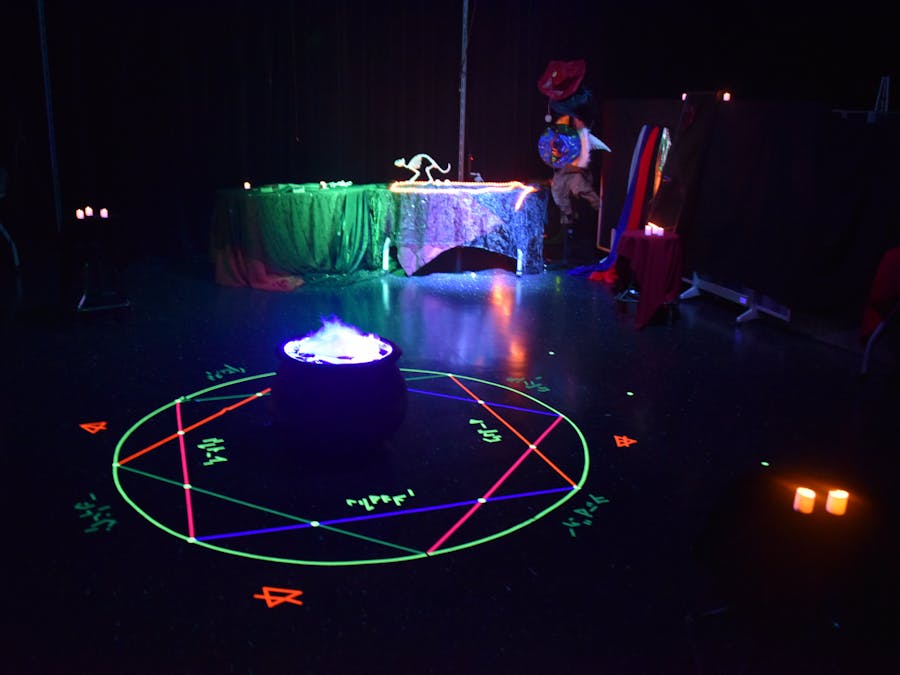http://transformativeplay.ics.uci.edu/magia-transformo/
Project DescriptionMagia Transformo is a playful physical experience with Internet of Things and digital augmentations. Three players enter a ritual chamber furnished with an altar and a rack of hats and cloaks. A glowing magic circle is laid out on the floor, with a cauldron in the center. Colored flames periodically shoot out of the cauldron. The voice of Alistair - a magical mentor figure - welcomes the neophyte witches to their initiation into the mysteries of the arcane. He invites the players to each select a hat and a cloak, and sanctify them at the magical altar. When players touch their magical garment to the altar, interactive spellbooks light up, with information about the mythos and history of each item. Once properly attired, the three witches are transformed into members of one of several secret magical societies (each with their own history and mythology to unlock) and invited by Alistair to pick up their spellbooks and gather around the magic circle. Following guidance from their spellbooks the players chant magic words, and dance around the cauldron to cast magical spells. If the players successfully complete the rituals, and the right combination of hats and cloaks have been selected, a spell will unlock, and the cauldron will emit colorful flames. Players may then return to the altar to explore other combinations of hats and cloaks, unlocking more spells in their spellbooks, and discovering more about the hidden world that they've entered into.
Magia Transformo is a design experiment, intended to explore new kinds of gameplay experiences that don’t fit neatly into existing genres or platforms. We hope that it can illuminate new design spaces for games that embrace the complex interconnections between physical embodied experiences, social interactions, and self-perception. The recent proliferation of “escape rooms” and “augmented reality” games (like Pokémon Go) demonstrates that people are eager for playful experiences that extend beyond the screens of their devices, but the high-profile failure of embodied interfaces like Microsoft’s Kinect sensor suggests that designing hybrid physical-digital experiences requires new literacies and new ways of thinking about play. Magia Transformo demonstrates how rich narrative elements and an emphasis on the role and identity of the player can create new possibilities for hybrid digital-physical game designs.
In the Transformative Play Lab we study and create experiences that live at the intersection of play and theater. We draw on techniques from interactive theater and actor training to create a sense of character identification through play, using novel hardware interfaces and digitally augmented environments to support an experience of “outside->in” identity transformation. Magia Transformo is an experiment in wearable game interfaces, where the core gameplay mechanic lies in the selection of different costume pieces. We know from our studies of actors that costumes, makeup, props, and masks play a significant role in producing the sensation of “becoming another person” on stage. Magia Transformo takes this as the inspiration for a game about magical transformation where the players must attire themselves as different characters as they explore and discover the hidden stories of our magical world. The act of putting on a costume, and seeing oneself in a mirror can be many things: playful, silly, dramatic, powerful, and transformative. Hats and cloaks invite players to adopt new body language, or twirl and swoop. They give players permission to embrace the fiction of the game, and to fully enter into the imaginary world of Magia Transformo.
To accomplish the technical challenges inherent in this design, we’ve had to draw on a wide range of sensing technologies. The “magical altar” is equipped with an RFID reader, and each costume piece has an RFID tag incorporated into it in the form of a “magical medallion”. The spellbook interfaces use android phones embedded in physical books, that provide a direct connection to the game server, and act as beacons for a Kinect sensor mounted above the cauldron. The magic cauldron has a ring of addressable “neopixels” that cast colored light on a set of silk flames that are blown upward by a circular fan. Using an Arduino microcontroller, we can control this magical fire to simulate many different visual effects. Taken together, all of these elements conspire to create a narratively rich atmosphere that knows where the players are and what they are wearing, and can respond by altering the ambience of the room, transmitting instructions to the spellbooks, or providing spoken support and suggestions to players.
Our initial design called for colored smoke pouring out of the cauldron. We prototyped this with a fog machine, which worked perfectly for 30 seconds before setting off the smoke alarm and evacuating the building. We revised our design so that colored flames danced inside the cauldron, allowing us to retain the same electronics configuration. For public performances we intend to supplement the “flames” with dry-ice based smoke.
As initially conceived, there was no dance in the game, however as the game developed we realized that it was important to give players something to do once in costume. By expanding on the notion of the magical ritual we enhanced the performative qualities of the play, and added an element of skill to the game. Implementing the dance also provided inspiration for the spellbooks, which gives the players a handheld feedback device – something that was sorely lacking in our initial designs.
In its current form Magia Transformo achieves all of our initial design goals with all the IoT technologies implemented, but it is only the tip of the iceberg. We are currently collaborating with Holly Poe Durbin – an award-winning costume designer – to create richly textured costumes especially for this story. We are fine-tuning the user experience, and deepening the mythos of the game’s narrative world, so that there is the potential for long-term engagement and deep play. We’re adding spells, dance moves, and an internal economy to support an experience that transcends the initial novelty factor of the game. We’re also pursing ongoing research around the game, in order to test and refine our transformative game design principles for future work.
In terms of technology, this project integrated RFID, Vision-based Localization, Wireless Network, and Embedded System. All the technologies used in this project are developed with open or easily accessible hardware and software. To move this project into other places with different light conditions, the vision-based localization may need to be re-calibrated and re-implemented with other algorithms, but a variety of computer vision techniques are available to achieve the goal of detection and tracking with a fixed camera in a controlled environment. The Arduino 101 provides wireless features to eliminate the inconvenience of setting up wired connections. Therefore, this project is totally feasible to be a commercial product that delivers novel user experience in the next two years.
In terms of the application field, we believe this project is applicable in entertainment and education. Some creators in the team have experience in the current states of playful physical experience like "exiting rooms" in Beijing, Shanghai, and Los Angeles. Few of them have the same level of richness in media technology and narratives as we created in this project. More importantly, the project has potential to be adapted to provide the experience of identity transformation for educational purposes: the narratives of the game can be adapted with educational contents, while the core mechanics of wearable interaction and exploratory participation of the users keep the gamification aspect. Wearing the costumes can give people a profound experience of what it must be like to walk a day in another’s shoes. The power of participatory forms is that they are active – they necessitate that players enact their lessons, and experience them through a visceral cycle of cause-and-effect. As the similar effects of VR and AR technology on learning have proven in recent studies, we believe that the novelty of this hybrid physical experience would also provide new motivations for students to learn through a playful, exploratory, and interactive experience. Furthermore, the physical environment can be designed to match the digital information that users will learn. For example, the installation of the project can be in an interactive museum to add physical contexts for learning the lives of people in history. This project demonstrates new design spaces to incorporate the co-design of the physical and digital worlds for exploring educational contexts, which could be a challenge for traditional education techniques delivering only digital information without embodied interactive experience.
Creator BackgroundJoshua Tanenbaum is an artist, a maker, and has been making and studying games for almost 20 years. He holds a Ph.D. from Simon Fraser University, where he studied Interactive Arts + Technology. His work explores the intersection of theater and games, by applying theories from actor training to understanding commercial games and by drawing on techniques from the performing arts to create new novel gameplay experiences. Dr. Tanenbaum is currently an Assistant Professor at UC Irvine, in the Department of Informatics. He is a co-founder of the Transformative Play Lab, a member of UCI’s Institute for Virtual Environments & Computer games, and an affiliated member of the EVOKE Lab and the Laboratory for Ubiquitous Computing and Interaction (LUCI). He chairs the Computer Game Science steering committee, and is the advisor for UCI’s Video Game Development Club.
Ke Jing is a Ph.D. student in the Informatics Department at UC Irvine, advised by Dr. Joshua Tanenbaum. He is a member of the Transformative Play Lab. He is the game technologist of Magia Transformo.
Natalie Nygaard is a graduating senior at UCI studying Computer Game Science. She is the lead designer for Magia Transformo, and is completing a thesis for the campus wide honors program about the design of the game.
Vincent Chang is a software engineering student whose hobby and passion is music. He has been creating music in a wide variety of genres and styles since 2010.
Mark Pareja is a fourth-year undergraduate student at UC Irvine studying Computer Game Science. He is a member of UCI's Video Game Development Club. He is the artist of Magia Transformo.
Karen Tanenbaum is a Research Scientist at UC Irvine, where she directs the EVOKE Lab, and is a co-founder of the Transformative Play Lab. She also holds a Ph.D. from SFU’s School of Interactive Arts + Technology, where she studied tangible computing and expert systems.
Submission BackgroundWe (Josh & Karen) have been wanting to make something like Magia Transformo since 2008, but it hasn’t been until recently that we’ve had the resources to make our dream a reality. For many years we’ve been talking about the narrative power of costumes as game controllers, but until recently that work has been purely theoretical. Magia Transformo is the first time we’ve put many of our design principles into action in a single piece.
As originally conceived, Magia Transformo was going to combine two of our favorite experiences: character creation, and playing dress up. We envisioned a room filled with costume pieces for the player to try on. Each piece would be connected to a game ability, or character element, such that the player would slowly transform into a unique character as they assembled an outfit. We prototyped pieces of this vision, including our tangible/wearable interactive storytelling system The Reading Glove, which tells a story across a collection of evocative objects. We worked with friends and colleagues around the world to run workshops around the idea of costumes and wearables as game controllers, created a lot of quick and dirty prototypes, and kept this idea in our back pockets until the right opportunity presented itself.
When Natalie Nygaard (one of our top game design students) approached us about doing an Honors thesis in the lab, we suggested the possibility of doing a game where trying on different costumes was the core mechanic. Natalie was enthusiastic about this idea, so we put our heads together. The game that emerged was Magia Transformo – a game with combinatorial mechanics inspired by games like Little Inferno, but with our own wearable twist. We quickly realized that this idea was bigger than a single honors thesis, so we brought one of Josh’s PhD students – Ke Jing (a specialist in robotics, camera vision, and augmented reality) – onboard to help with the hardware integration for the system. As the project evolved and expanded two more students joined us: Vincent Chang (the “fastest composer in the West”) and Mark Pareja (master of the pixel). Most of the members of the team have donated their time to the project, with at most a few units of college course credit in recompense.
Professor Tanenbaum has funded the purchase of costume elements, prototyping supplies and hardware out of the small pool of research funds available to his lab. Most of the spooky décor comes from Josh and Karen’s own substantial collection of Halloween items. The game’s design has evolved substantially since we began working on it in the Fall. Initially we planned for there to be 4 players, and for the costumes to include goggles, belts, pendants, and magic staffs, however the combinatorial possibilities of this escalated beyond our ability to author, so we scaled back the design to Hats and Cloaks for Three Players. With six types of each (and disregarding order) we were able to scope the number of possible combinations down to 400 – a number that will keep us busy for a very long time.
More videosMagia Transformo gameplay video without editing (2:55)
Magia Transformo: Costume Sanctification and Solo Gameplay:
Magia Transformo Trailer:





_baVEVgguW1.jpg?auto=compress%2Cformat&w=48&h=48&fit=fill&bg=ffffff)











Comments
Please log in or sign up to comment.